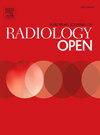Spectral computer-tomography and the ability to detect occult femoral neck and scaphoid fractures – A systematic review and exploratory meta-analysis
IF 2.9
Q3 RADIOLOGY, NUCLEAR MEDICINE & MEDICAL IMAGING
引用次数: 0
Abstract
Objective
This systematic review aims to describe the ability of spectral computed tomography (SCT) to identify bone marrow oedema (BME) in the scaphoid bone and the femoral neck compared to magnetic resonance images (MRI).
Materials and methods
PubMed, Embase and Cochrane Library were searched from the 1st of October 2024; eligible studies had patients over 15 years of age, underwent SCT and had MRI as a gold standard. Sensitivities, specificities, negative predictive values (NPV) and positive predictive values (PPV) were noted or calculated from available information. Bias and applicability were assessed using QUADAS-2 tools. A random-effects model was used in the meta-analysis, and heterogeneity was assessed using I2 statistics.
Results
1061 studies were identified and screened by title/abstract. Twenty-two studies underwent full-text assessment. A total of four were included, of which three were suitable for meta-analysis regarding the scaphoid bone. Pooled sensitivity was 93 %, specificity was 98 %, PPV was 92 % and NPV was 98 %. A single study concerning the femoral neck was located, with sensitivity, specificity, PPV and NPV of 87 %, 94 %, 93 % and 89 % respectively.
Conclusions
Data regarding the ability of SCT to detect BME in the femoral neck and scaphoid bone are promising, but limited, with only small studies available. There is a need for larger prospective studies, regarding both the detection of occult fractures in the femoral neck and the scaphoid bone.
光谱计算机断层扫描和检测隐匿性股骨颈和舟状骨骨折的能力-系统回顾和探索性荟萃分析
目的:本系统综述旨在描述光谱计算机断层扫描(SCT)识别舟状骨和股骨颈骨髓水肿(BME)的能力,并与磁共振成像(MRI)进行比较。资料与方法检索自2024年10月1日起的spubmed、Embase和Cochrane Library;符合条件的研究有15岁以上的患者,接受了SCT和MRI作为金标准。敏感性、特异性、阴性预测值(NPV)和阳性预测值(PPV)被记录或从现有信息中计算。使用QUADAS-2工具评估偏倚和适用性。meta分析采用随机效应模型,采用I2统计量评估异质性。结果通过标题/摘要对1061项研究进行了筛选。22项研究进行了全文评估。共纳入4例,其中3例适合用于舟状骨的meta分析。敏感性为93 %,特异性为98 %,PPV为92 %,NPV为98 %。我们找到了一项关于股骨颈的研究,其敏感性、特异性、PPV和NPV分别为87 %、94 %、93 %和89 %。结论:关于SCT检测股骨颈和舟状骨BME的能力的数据是有希望的,但有限,只有少量的研究可用。对于股骨颈和舟状骨隐匿性骨折的检测,需要进行更大规模的前瞻性研究。
本文章由计算机程序翻译,如有差异,请以英文原文为准。
求助全文
约1分钟内获得全文
求助全文
来源期刊

European Journal of Radiology Open
Medicine-Radiology, Nuclear Medicine and Imaging
CiteScore
4.10
自引率
5.00%
发文量
55
审稿时长
51 days
 求助内容:
求助内容: 应助结果提醒方式:
应助结果提醒方式:


